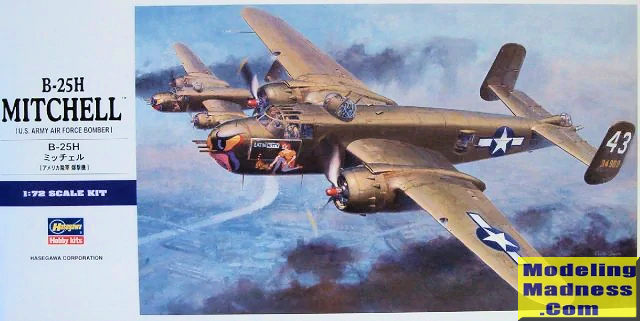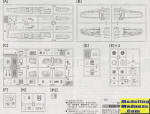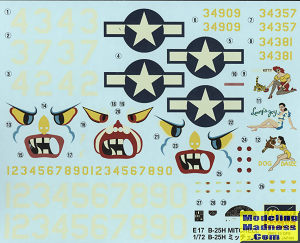
Hasegawa 1/72 B-25H Mitchell
| KIT #: | 00547 |
| PRICE: | 3200 yen SRP |
| DECALS: | Three options |
| REVIEWER: | Scott Van Aken |
| NOTES: | 2003 base boxing |

| HISTORY |
The 12th Bomb Group was relieved from combat operations in Italy in early February 1944, and ordered to proceed by British ship back through the Suez Canal and on to India to help the British Fourteenth Army repel a Japanese invasion from Burma at Imphal in a war threatening the whole subcontinent and the Indian Ocean. They arrived at Bombay on 12 March 1944, and after a four-day train trip to Calcutta and a day on a river boat to Dacca in eastern Bengal, the 81st and 82nd occupied a field at Tejgaon Airfield and the 83rd and 434th at Kurmitola Airfield.
The 12th was equipped with new B25Hs and B-25Js and flew its first mission as part of the Tenth Air Force, bombing Japanese supply dumps at Mogaung, Burma, on 16 April 1944. A similar situation to El Alamein existed where a couple of divisions of the British Army were surrounded by a Japanese force at Imphal, the gate way to India from Burma, and threatened British control of the whole sub-continent and the Indian Ocean. The British still controlled an airstrip, however, and the 12th were called upon to fly ammunition to the British troops, landing behind Japanese lines to unload the ammunition carried in their bomb bays. After three weeks of "ammo" runs, the British had defeated the Japanese invasion and prevented their invasion of India.
After some vicious fighting, the British captured Meiktila on 3 March and swept down the road to Mandalay, which was defended by 400-year-old Fort Dufferin complete with high thick walls and a wide moat. The 12th was called upon to bomb the fort on 9 March 1945, which they did successfully with 2000-pound bombs dropped from 200 feet by four Mitchells, followed by attacks from 6000 feet by another squadron, and a 35-ship blasting of the entire area of the fort to complete the job.
The last major mission of the 12th was an overnight where the crews spent the night under the wings of their B-25s at Rameree, near Rangoon, and took off the next morning to bomb Ban-Takli airfield north of Bangkok, Thailand after which they were reequipped with new Douglas A-26 Invaders and were still training when the war ended.
| THE KIT |
 This is,
as mentioned, the basic boxing for the B-25H as such, it provides markings for
three planes from the 82nd Bomb Squadron. There have been two other boxings so
far, one being a PBJ-1H and the other with similar markings to the basic boxing.
H models were used more than with the 82nd and the Marines so I'm surprised that
some of those other, somewhat less flamboyant, markings have not been boxed.
This is,
as mentioned, the basic boxing for the B-25H as such, it provides markings for
three planes from the 82nd Bomb Squadron. There have been two other boxings so
far, one being a PBJ-1H and the other with similar markings to the basic boxing.
H models were used more than with the 82nd and the Marines so I'm surprised that
some of those other, somewhat less flamboyant, markings have not been boxed.  decal to
fit.
decal to
fit. | CONCLUSIONS |
The only other B-25H in this scale is the fairly old Italeri kit that is based on their B-25J. These can be difficult to locate as their releases are spotty, but they can be found.
| REFERENCES |
https://en.wikipedia.org/wiki/12th_Operations_Group
January 2019
Copyright ModelingMadness.com. All rights reserved If you would like your product reviewed fairly and fairly quickly, please contact the editor
or see other details in the
Note to
Contributors. Back to the Main Page
Back to the Review
Index Page
Back to the Previews Index Page